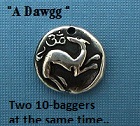Particle Physics Research Sheds New Light On Possi
Post# of 63897

P article Physics Research Sheds New Light On Possible 'Fifth Force of Nature'
In a breakthrough for the field of particle physics, Professor of Physics Larry Hunter and colleagues at Amherst College and The University of Texas at Austin have established new limits on what scientists call "long-range spin-spin interactions" between atomic particles. These interactions have been proposed by theoretical physicists but have not yet been seen. Their observation would constitute the discovery of a "fifth force of nature" (in addition to the four known fundamental forces: gravity, weak, strong and electromagnetic) and would suggest the existence of new particles, beyond those presently described by the Standard Model of particle physics.

This picture depicts the long-range spin-spin interaction (blue wavy lines) in which the spin-sensitive detector on Earth’s surface interacts with geoelectrons (red dots) deep in Earth’s mantle. The arrows on the geoelectrons indicate their spin orientations, opposite that of Earth’s magnetic field lines (white arcs)
The new limits were established by considering the interaction between the spins of laboratory fermions (electrons, neutrons and protons) and the spins of the electrons within Earth. To make this study possible, the authors created the first comprehensive map of electron polarization within Earth induced by the planet's geomagnetic field.
Hunter -- along with emeritus Amherst physics professor Joel Gordon; postdoctoral fellow Stephen Peck; student researcher Daniel Ang '15; and Jung-Fu "Afu" Lin, associate professor of geosciences at UT Austin -- co-authored a paper about their work that appears in this week's issue of the journal Science . The highly interdisciplinary research relies on geophysics, atomic physics, particle physics, mineral physics, solid-state physics and nuclear physics to reach its conclusions.
The paper describes how the team combined a model of Earth's interior with a precise map of the planet's geomagnetic field to produce a map of the magnitude and direction of electron spins throughout Earth. Their model was based in part on insights gained from Lin's studies of spin transitions at the high temperatures and pressures of Earth's interior.
Every fundamental particle (every electron, neutron and proton, to be specific), explained Hunter, has the intrinsic atomic property of "spin." Spin can be thought of as a vector -- an arrow that points in a particular direction. Like all matter, Earth and its mantle -- a thick geological layer sandwiched between the thin outer crust and the central core -- are made of atoms. The atoms are themselves made up of electrons, neutrons and protons that have spin. Earth's magnetic field causes some of the electrons in the mantle's minerals to become slightly spin-polarized, meaning the directions in which their spins point are no longer completely random, but have some net orientation.
Earlier experiments, including one in Hunter's laboratory, explored whether their laboratory spins prefer to point in a particular direction. "We know, for example, that a magnetic dipole has a lower energy when it is oriented parallel to the geomagnetic field and it lines up with this particular direction -- that is how a compass works," he explained. "Our experiments removed this magnetic interaction and looked to see if there might be some other interaction that would orient our experimental spins. One interpretation of this 'other' interaction is that it could be a long-range interaction between the spins in our apparatus, and the electron spins within the Earth, that have been aligned by the geomagnetic field. This is the long-range spin-spin interaction we are looking for."
So far, no experiment has been able to detect any such interaction. But in Hunter's paper, the researchers describe how they were able to infer that such so-called spin-spin forces, if they exist, must be incredibly weak -- as much as a million times weaker than the gravitational attraction between the particles. At this level, the experiments can constrain "torsion gravity" -- a proposed theoretical extension of Einstein's Theory of General Relativity. Given the high sensitivity of the technique Hunter and his team used, it may provide a useful path for future experiments that will refine the search for such a fifth force. If a long-range spin-spin force is found, it not only would revolutionize particle physics but might eventually provide geophysicists with a new tool that would allow them to directly study the spin-polarized electrons within Earth.
"If the long-range spin-spin interactions are discovered in future experiments, geoscientists can eventually use such information to reliably understand the geochemistry and geophysics of the planet's interior," said Lin.
Possible future discoveries aside, Hunter said that he was pleased that this particular project enabled him to work with Lin. "When I began investigating spin transitions in the mantle, all of the literature led to him," he explained. "I was thrilled that he was interested in the project and willing to sign on as a collaborator. He has been a good teacher and has had enormous patience with my ignorance about geophysics. It has been a very fruitful collaboration."
Lin had his own take: "The most rewarding and surprising thing about this project was realizing that particle physics could actually be used to study the deep Earth."
 (0)
(0) (0)
(0)